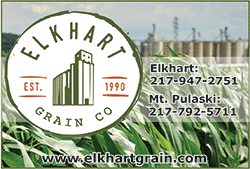|
An economic driver for the
state for 100 years, the soybeans I grow right here in Atlanta
support a number of industries, including livestock production and
renewable fuels, and are a mainstay in the state’s global exports.
But what does that mean for Logan County farmers like me, especially
with spring planting just around the corner? And how can farmers
here in Logan County further the county’s production and export of
soybeans?
Illinois Leads the Nation
For 100 years, Illinois has been a leader in soybean production.
Beginning in 1924, just as soybean production was beginning to take
hold in the U.S., Illinois took the lead and never looked back.
Through most of the 1930s, Illinois produced more than 50% of the
nation’s soybeans. This is due in large part to leading research
from the University of Illinois Extension. Suitability of the
soybean to the climate and changing cropping systems in Illinois
also played a key role as well as leadership in soybean crushing,
particularly by Staley Manufacturing in Decatur. Development of
combines for harvesting soybeans, and an ongoing commitment to
research and development of soybeans and soybean varieties by
various departments at the University of Illinois, further increased
soybean acres in Illinois.

Today, Illinois still leads
the nation, ranking as the top soybean-producing state in nine of
the last 10 years. In fact, Illinois leads the nation in acres
planted to soybeans – averaging 9.8 million acres – in the last 20
years. Here at home, Logan County is ranked no. 13 among the state’s
102 counties for soybean production.
The soybeans grown in Logan County – nearly 11 million bushels’
worth – and throughout Illinois feed livestock, create biofuels and
are exported overseas, maintaining demand for farmers like me.
2024 Soybean Outlook
Still, despite our ability to grow more soybeans than ever before,
I’m still faced with a number of complications and challenges to
deliver high-quality soybeans on the global market.
Changing weather patterns have played a large role in past growing
seasons – from wet springs to prolonged drought. Weed pressures and
chemical control have been difficult to navigate as options become
less effective. Markets have taken a hit recently and drive many
decisions for crops to be planted this spring. Across the board,
evaluating environmental and market outlooks for this upcoming
growing season, it will be interesting to see how many soybeans
acres will be planted.
For example, the U.S. Department of Agriculture’s (USDA) 2024
Commodity Outlook calls for a reduction in commodity crop acres this
year, due in part to lower commodity prices and increasing interest
rates.
Specific to soybeans, the USDA’s outlook calls for higher use,
ending stocks, and supplies –in fact, supplies are forecast to climb
to 4.5 billion bushels, up 8% from the 2023 crop year – a recipe for
lower prices for farmers.
Here in Logan County, I’m expecting a slight increase in soybean
acres due to soybeans offering a better net return per acre when
compared to corn. I think the increase will be minimal because crop
rotation is extremely important to Logan County farmers, and
spreading out our risk while decreasing potential pest problems in
our crops is a big plus.

Driving Demand
Roller coaster markets are nothing new. And, despite lower prices,
demand for soybeans and soybean products remains high. The U.S.
crush capacity – the process of making soybean meal for livestock
feeds and other products – is going up, driving demand both
domestically and internationally. And lower prices will likely
further international demand for U.S. soybeans.
Renewable biodiesel also will continue to drive soybean oil demand,
with that market growing by 8% to 14 billion pounds. Additionally,
Illinois will send around half of the soybean oil the state produces
into the food industry – a vital market for continued demand.
Despite higher supplies and dipping prices, growth in these areas of
the soybean market are bright spots – and potential opportunities –
for farmers looking at the stability and potential growth of the
soybean market.
2024 and Beyond
I’ve farmed in Logan County for more than 44 years and I can say,
without a doubt, the only thing constant in farming is change. As a
long-time member of the Illinois Soybean Association – and now, as
board chair – I’ve gotten a firsthand look at how we change.
Instead of adhering to the “this is the way we’ve always done it”
mantra, farmers like me have chosen to embrace and champion changes
in consumer tastes by adding sustainability programs and higher
efficiency and higher quality products as we modernize our farms and
look for new ways to drive demand and profit.
[to top of second column] |

Paying attention to a few key
factors can help farmers stay ahead of the curve and take advantage
of the rapidly changing soybean market:
Focus on Quality
For most farmers, potential yield is the determining factor when
choosing seed and other parameters. And while yield is definitely
still important, the global marketplace continues to place
increasing importance on soybean meal and oil quality.
In fact, soybean oil quality will be an important production grade
to stay competitive in the marketplace. As consumer demand grows,
research will continue to develop studies examining soybean
production return on investment, with a focus on quality alongside
yield. Regional opportunities could be available for farmers to take
advantage of this space.
Growth of Biofuels
Biodiesel has been around for a while and will continue to drive
demand in the renewable fuels market. But the latest entrant to this
space – sustainable aviation fuel – will likely add to soy demand
for biofuels’ strong upward trend.
Consumers Want More Protein
The world’s growing population needs additional protein, and I’m not
just talking about animal protein. While animal protein will likely
remain a mainstay, of which soybeans are an important feed source
(here in Illinois, livestock are the no. 1 consumer of soybeans),
alternative proteins for human consumption are on the rise. Soybeans
are uniquely poised to answer the call for both.

The U.S. Needs Global
Buyers
Illinois’ soybean growers have long delivered a high-quality product
to our global buyers. To continue to build these important
relationships, the Illinois Soybean Association invites global
buyers to Illinois farms annually, showing them how farmers like me
raise soybeans in environmentally conscious ways.
Here to Stay
A less-than-positive outlook on commodity prices is never pleasant,
especially heading into planting. Still, for soybean farmers like
me, there’s still much to appreciate about the role soybeans play in
our local, state, regional and global economies.
As farmers, we work to raise high-quality products that feed and
fuel the world and organizations like the Illinois Soybean
Association work to ensure we have places to sell our products,
ensuring soybeans are here to stay, supporting families like mine
this year and for many years to come.
[Ron Kindred
Board Chair, Illinois Soybean Association
Logan County Agricultural Producer]
Ron Kindred, from Atlanta, Ill., is Chairman of the Illinois
Soybean Association (ISA). He farms with his wife, Jayne, and son
Jay, raising soybeans and corn. Kindred is a previous ISA director,
having served the association for 13 years, including time as vice
president, secretary and legislative chairman and participation in
several committees. He was also a past chairman of Illinois Soybean
Growers (ISG) SoyPac and a Soy Advocate for ISG’s Voice for Soy
program. Kindred also represented Illinois on the American Soybean
Association board and was both vice president and secretary for that
group. He is active with Illinois Farm Bureau and has served as
President of East Lincoln Farmers Grain Co-op and Atlanta Township
Trustee.
 |